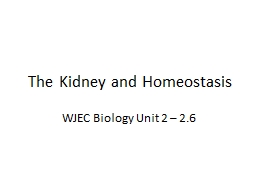

WJEC Biology Unit 2 26 What is the job of the urinary system To regulate the volume and composition of body fluids removing waste products from the body and expelling the waste and excess water from the body in the form of urine ID: 1033215
Download Presentation The PPT/PDF document "The Kidney and Homeostasis" is the property of its rightful owner. Permission is granted to download and print the materials on this web site for personal, non-commercial use only, and to display it on your personal computer provided you do not modify the materials and that you retain all copyright notices contained in the materials. By downloading content from our website, you accept the terms of this agreement.
1. The Kidney and HomeostasisWJEC Biology Unit 2 – 2.6
2. What is the job of the urinary system?To regulate the volume and composition of body fluids, removing waste products from the body and expelling the waste and excess water from the body in the form of urine.
3. The kidneyYour kidneys remove the poisonous substances which your cells produce.Our bodies break down the protein in our food into amino acids. The diagram shows what happens to these amino acids:Some are used for growth and repairSome are not used – they are broken down in the liver
4. The main poison your kidneys removeUrea is made in the liver from amino acids. Urea is a poisonous substance. Your kidneys remove it from your blood. They also remove excess salt (ions) from your blood. The urea and salts are dissolved in water to make a liquid called urine.
5. Interesting factsThe kidneys filter about 1.3 litres of blood a minute.All the body’s blood flows through the kidneys every 10 minutes, so blood is filtered 150 times a day.
6. Excretory systemrenal vein kidneysbladderurethrarenal artery ureterssphincterCarries cleaned blood away from the kidneysRemove urea and other wasteA bag that stores urineA tube which carries urine out of your bodyCarries ‘dirty’ blood (with waste) into the kidneysTubes which carry urine to the bladderA ring of muscle that keeps the bladder closed until you go to the toiletShow/hide arrowsShow/hide labelsShow/hide function
7. The structure of the kidneyRenal arteryRenal veinUreterMedullaCortexPelvisNephron within the kidneyShow/hide arrowsShow/hide labels
8. The nephronCollecting ductCapillary knotBowman’s capsuleTubuleCapillary networkShow/hide arrowsShow/hide labels
9. The nephron‘Dirty blood’Bowman’s CapsuleUseful substances are reabsorbed into the bloodUrine(urea and water)Urine‘Cleanedblood’CapillaryTubuleUrine goes to the bladderUseful substancesUrineThe diagram below shows a flattened section of the nephronBlood is filtered through the capillary knot. Nearly all the blood except red cells filters through into the nephronThe liquid in the nephron contains useful substances like glucose and vitamins. These are then absorbed back into the blood (reabsorbed).The liquid left in the nephron is urine. It contains urea and water and other unwanted substances. It then goes through the collecting duct and ureters to the bladder.
10. PostcardComplete the postcard to explain your journey through the excretory system. You are a water molecule travelling through the blood. Wish you were here…Dear Celia the Ciliated Epithelial Cell, I have been on the most incredible journey! It all started when…
11. Role of anti-diuretic hormoneIf there is too little water in your blood then the body detects this and the pituitary gland produces anti-diuretic hormone (ADH).ADH increases the permeabilityof the tubules, and allows the kidneys toreabsorb more water, making a more concentrated urine.The more ADH, the more concentrated the urine.
12. The kidneys and water controlToo much water in bodyToo little water in bodyWater in urineUrine colourPresence of ADHA littleYellowColourlessA lotClick the boxes below in order to select the correct wordMore ADHLess ADHCLICK HEREA littleYellowColourlessA lotMore ADHLess ADHCLICK HEREA littleYellowColourlessA lotMore ADHLess ADHCLICK HEREA littleYellowColourlessA lotMore ADHLess ADHCLICK HEREA littleYellowColourlessA lotMore ADHLess ADHCLICK HEREA littleYellowColourlessA lotMore ADHLess ADHCLICK HERE
13. Kidney graphsTime after drinking (mins)Time after drinking (mins)Volume of urine (ml)Salt concentration (ml)------ normal levelUse these graphs to answer the questions on the separate sheet…
14. Research TaskProduce a leaflet for someone with a kidney problem, outlining the advantages and disadvantages of the use of dialysis or transplantation. Remember to use science to explain the procedures and remember to use more than 2 sources of information to improve the reliability.Kidney failure can be treated by dialysis or by replacing it with a healthy one by transplant from a donor
15. What have we learnt?To know the role of the kidney To be able to label a diagram of the human excretory systemTo be able to label a section through the kidney and a nephronTo understand the role of ADH and interpret data about the presence of substances during the passage through the kidney